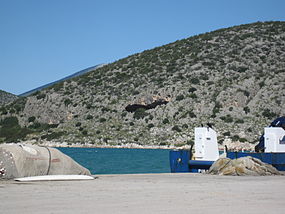 |
| Image taken from Wikipedia: http://en.wikipedia.org/wiki/Franchthi_Cave |
Franchthi cave is in southeastern Argolis,
Greece. The cave was continuously
occupied from 20,000-3,000 BC, from the Paleolithic through the Neolithic. It was excavated by T.W. Jacobsen from
1967-1979. The site is really
significant because it has some of the earliest evidence of agriculture in
Greece. The Mesolithic period is divided
up into two phases, because people were eating different things over time. In the first phase, people were eating mostly
red deer, some pig, and very few other things.
However, there are some small fish bones. In the second phase, people are still eating
mostly red deer and the occasional pig, but the fish bones here are large,
possibly tuna. The site contains
lentils, vetch, pistachios, almonds, wild oat seeds, wild barley seeds, wild
pears, and peas during the Mesolithic.
The number of pistachios increase around 8,000 BC, and wild oats and
barley become more common after 7,000 BC.
There are equid and caprine bones (horse, goat, and sheep species)
during the Mesolithic, but the number of these decrease around 8,000 BC, which
could suggest that people were choosing to eat other things (like more
pistachios), or that the surrounding landscape was turning into open
forests. In connection to the large fish
bones lots of obsidian from Melos was also found at the site. This shows that people were able to travel
across seas to trade for the obsidian, and the size of the fish bones may
suggest that people practiced deep-sea fishing.
However, there isn’t a substantial amount of the large fish bones, so it
can be argued that people drove the fish into shallow water and caught them
with clubs or spears. The site shows
that Greeks ate a variety of plants during the Mesolithic, but most of their
protein came from red deer and pigs, not fish.
 |
| Image from Wikipedia article about red deer: http://en.wikipedia.org/wiki/Red_deer |


No comments:
Post a Comment